Roma or ROMA may refer to:
Rome is the English form of the name of the capital city of Italy, and formerly capital of the Roman Empire and seat of the papacy, where it consistently has been called Roma.
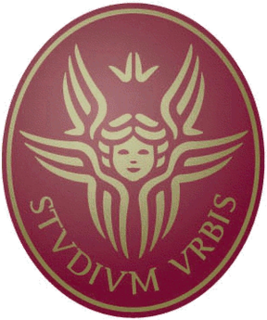
The Sapienza University of Rome, also called simply Sapienza or the University of Rome, is a collegiate research university that is located in Rome, Italy. Formally known as Università degli Studi di Roma "La Sapienza", it is one of the largest European universities by enrollments and one of the oldest in history, founded in 1303. The University is one of the most prestigious Italian universities and in the world, commonly ranking first in national rankings and in Southern Europe. In 2018 it ranked 1st in the world for Classics and Ancient history.

The Rome Metro is a rapid transit system that operates in Rome, Italy. It started operation in 1955, making it the oldest in the country.
The city of Rome, Italy is divided into first-level administrative subdivisions. There are 15 municipi in the city; each municipio is governed by a president and a council who are elected directly by its residents every five years. The municipi collectively comprise the comune of Rome, which is itself one of the constituent parts of the wider metropolitan city of Rome Capital.
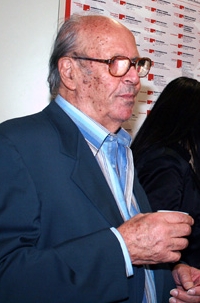
Vittorio De Seta was an Italian cinema director and screenwriter, considered one of the Italian cinema's great imaginative realists of the 1960s.

Acqua Vergine is one of several Roman aqueducts that deliver pure drinking water to Rome. Its name derives from its predecessor Aqua Virgo, which was constructed by Marcus Vipsanius Agrippa in 19 BC. Its terminal castellum is located at the Baths of Agrippa, and it served the vicinity of Campus Martius through its various conduits. In an effort to restore fresh water to Rome during the Renaissance, Pope Nicholas V, in 1453, renovated the main channels of the Aqua Virgo and added numerous secondary conduits under Campo Marzio. The original terminus, called a mostra, which means showpiece, was the stately, dignified wall fountain designed by Leon Battista Alberti in Piazza dei Crociferi. Due to several additions and modifications to the end-most points of the conduits during the years that followed, during the Renaissance and Baroque periods, the Acqua Vergine culminated in several magnificent mostre - the Trevi Fountain and the fountains of Piazza del Popolo.

Roma Tiburtina is the second largest railway station in Rome, after Roma Termini. Located in the north-eastern part of the city, it was originally constructed during the 1860s as a terminal station. In recent years, the station has been redeveloped to better serve as a hub for the Italian high-speed rail services. The station is connected to Rome's Metro line B at Tiburtina metro station, as well as to local bus services via an adjacent bus depot while private vehicle users are provided with more than 100,000 spaces across multiple on-site car parks.

Line A of the Rome Metro runs across the city from the north-west terminus of Battistini to the south-east terminus at Anagnina. It intersects with Line B at Termini and with Line C at San Giovanni. The line is marked orange on metro maps.

Via Vittorio Veneto, colloquially called Via Veneto, is one of the most famous, elegant, and expensive streets of Rome, Italy. The street is named after the Battle of Vittorio Veneto (1918), a decisive Italian victory of World War I. Federico Fellini's classic 1960 film La Dolce Vita was mostly centered on the Via Veneto area.
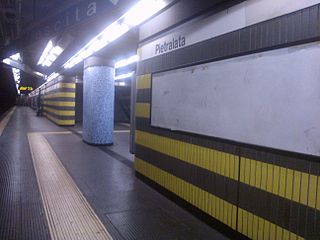
Pietralata is a station on Line B of the Rome Metro. It is located on Via di Pietralata, after which it is named, in the Pietralata quarter, the 21st quarter of Rome, near the Forte Tiburtino and the Autostrada A24.

Quintiliani is a station on Line B of the Rome Metro. It is located on Via della Pietra Sanguigna and takes its name from the ancient Casale dei Quintiliani, which stood near the station. Other nearby streets are Via delle Cave di Pietralata and Via del Casale Quintiliani. Nearby is the Ospedale Sandro Pertini.
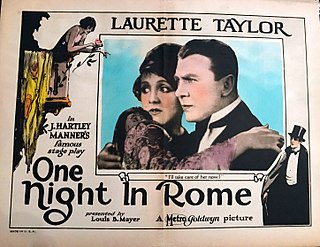
One Night in Rome is a 1924 film starring Laurette Taylor. The film was directed by Clarence G. Badger and written J. Hartley Manners, Ms. Taylor's husband, based upon his play. Laurette Taylor was a great name of the American theatre, who made only three films in a triumph-studded career, all of them derived from plays by her husband. This was the last of those three films. Ms. Taylor seems to have enjoyed making One Night in Rome as she kept a personal print of the movie to always show guests at her home, re-running it over and over again.
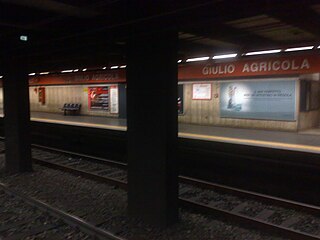
Giulio Agricola is an underground station on Line A of the Rome Metro. It is located on Via Tuscolana, on the junction with Viale Giulio Agricola and Viale Marco Fulvio Nobiliore, in an area where roads and squares are named after Roman commanders and consuls.

The Church of Saint Athanasius on Via Tiburtina is a Roman Catholic titular church in Rome, built as a parish church. It was consecrated 11 March 1961 by Cardinal Clemente Micara. On 28 June 1991 Pope John Paul II granted it a titular church as a seat for Cardinals.
Massimo Bonetti is an Italian actor and director.
Albino Bernardini was an Italian writer and pedagogue.

Pietralata is a 2008 Italian film directed by Gianni Leacche. The film concerns a protest against the current film industry, and it was shot in 2007 in the Pietralata, a quartiere of Rome, in the eastern part of the city.

Pietralata is the 21st quarter of Rome. It is part of the Municipio IV. Its name comes from the Latin Prata Lata meaning large fields, which is possibly a reference to the large amount of nature and vegetation present.
The Church of Saint Romanus the Martyr is a Roman Catholic titular church in Rome, Italy, in the Pietralata quarter.













